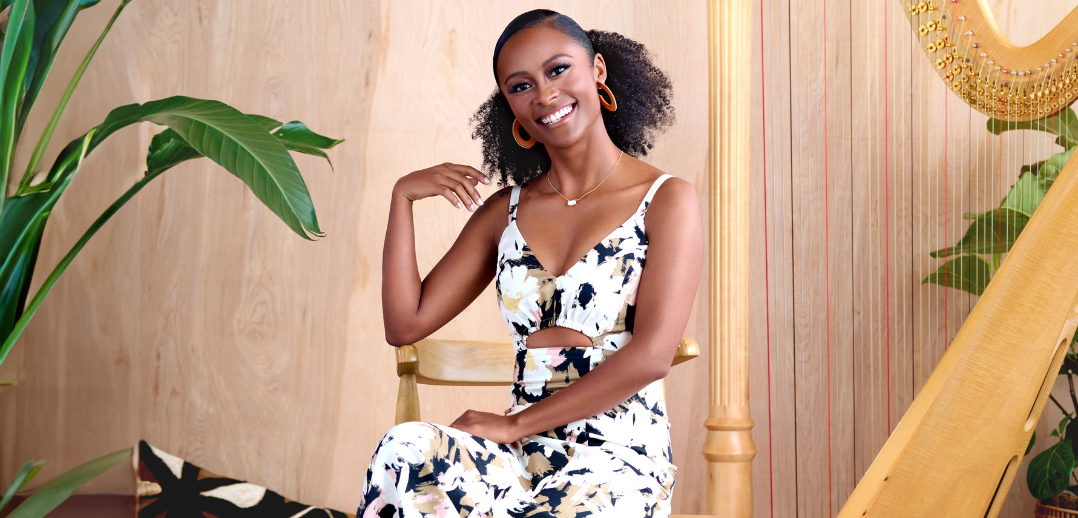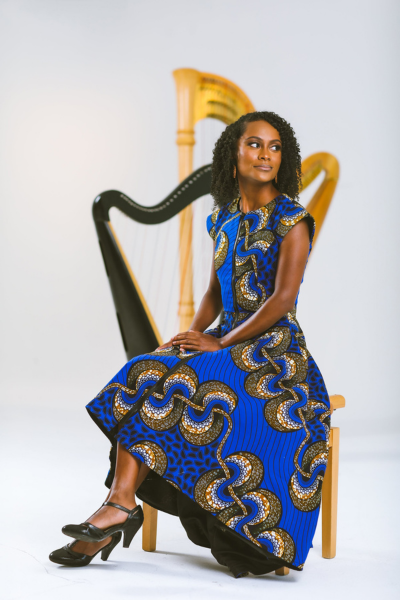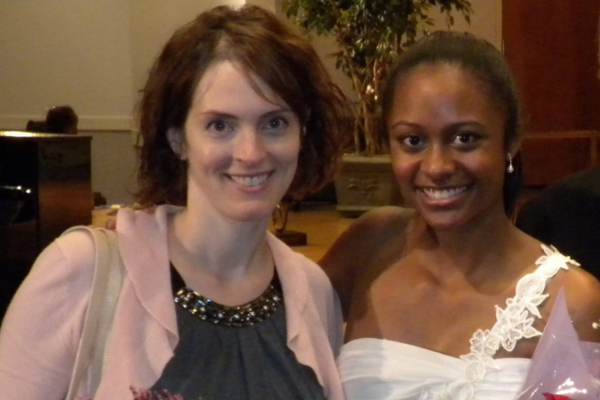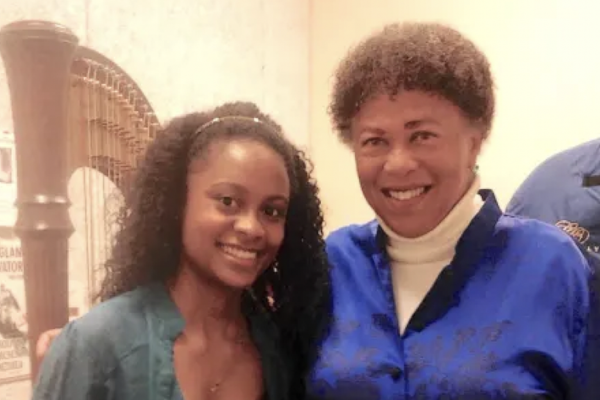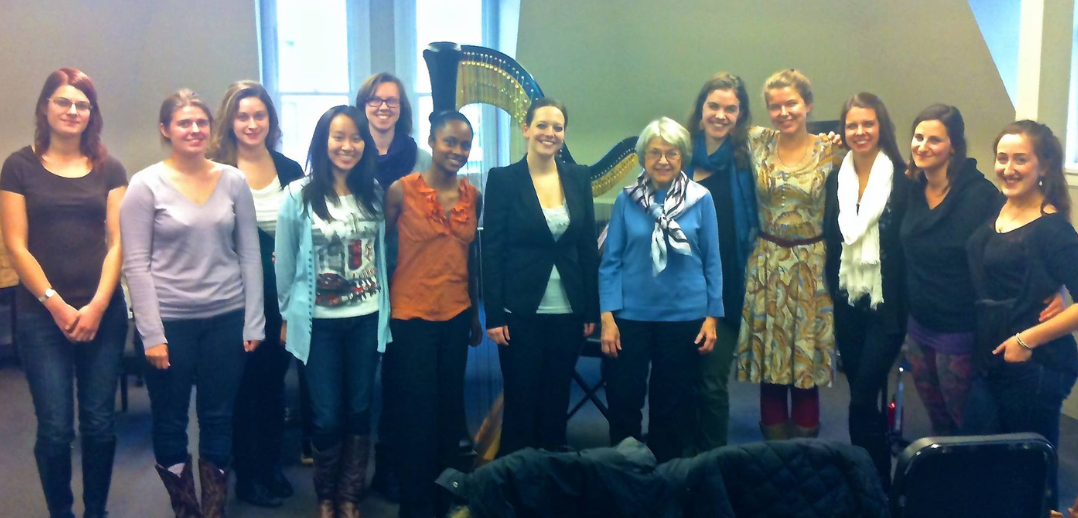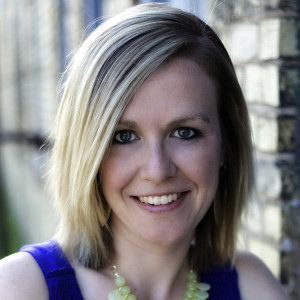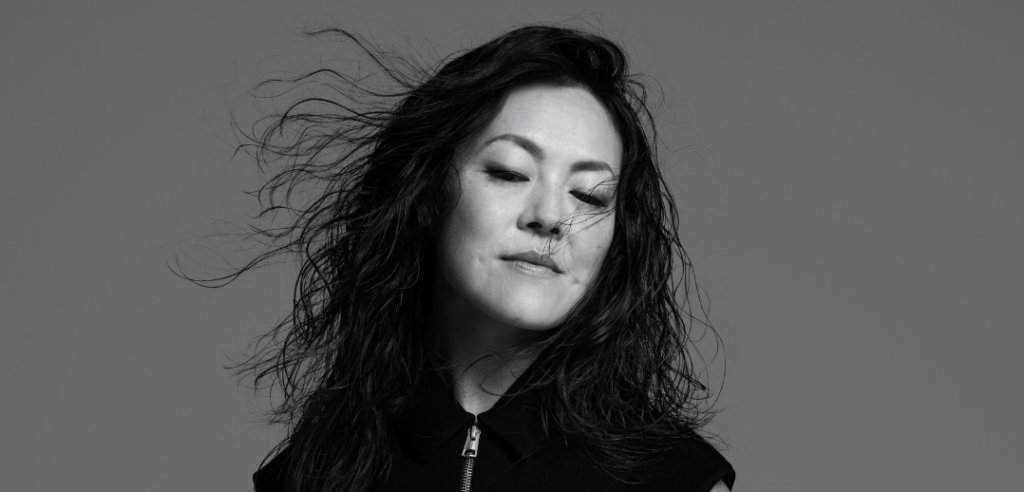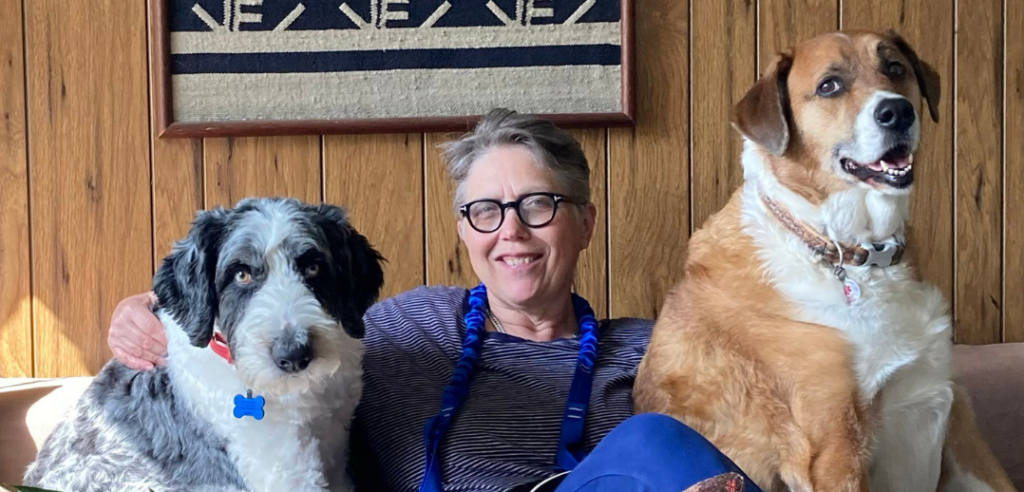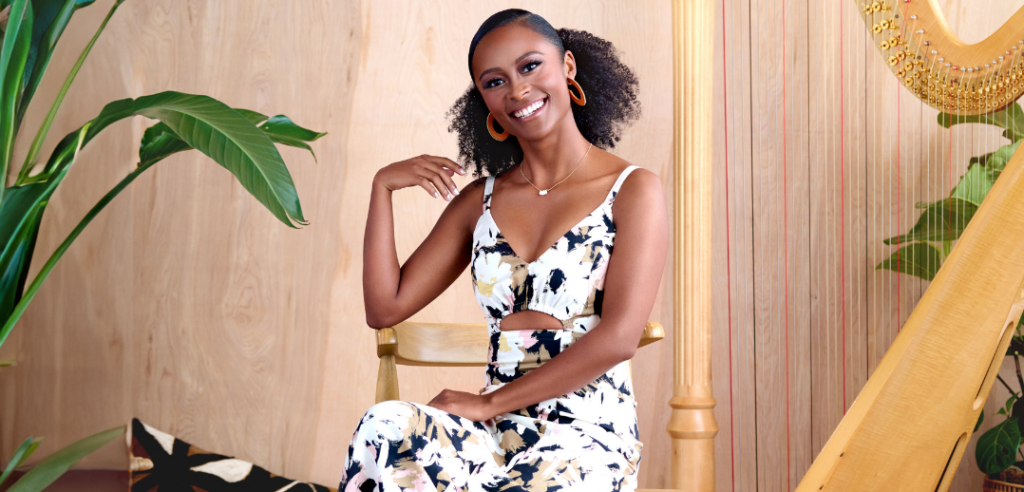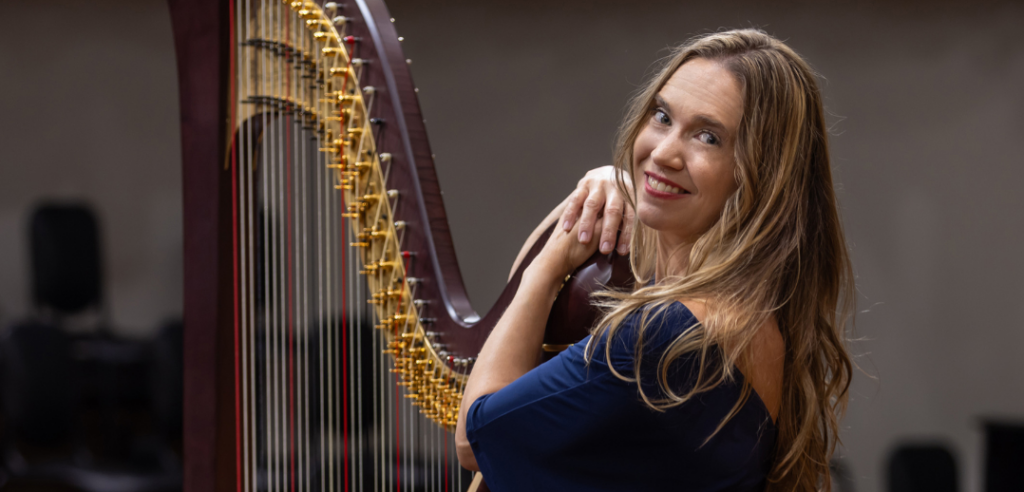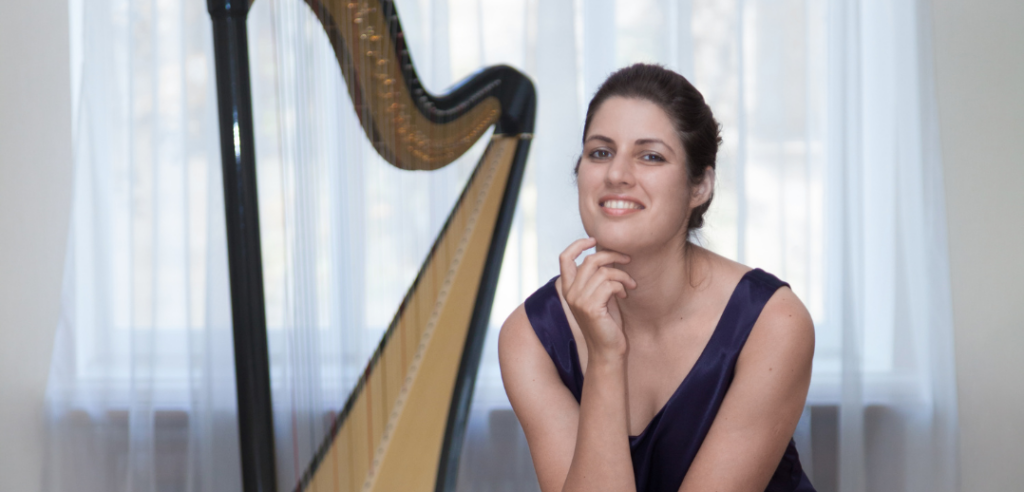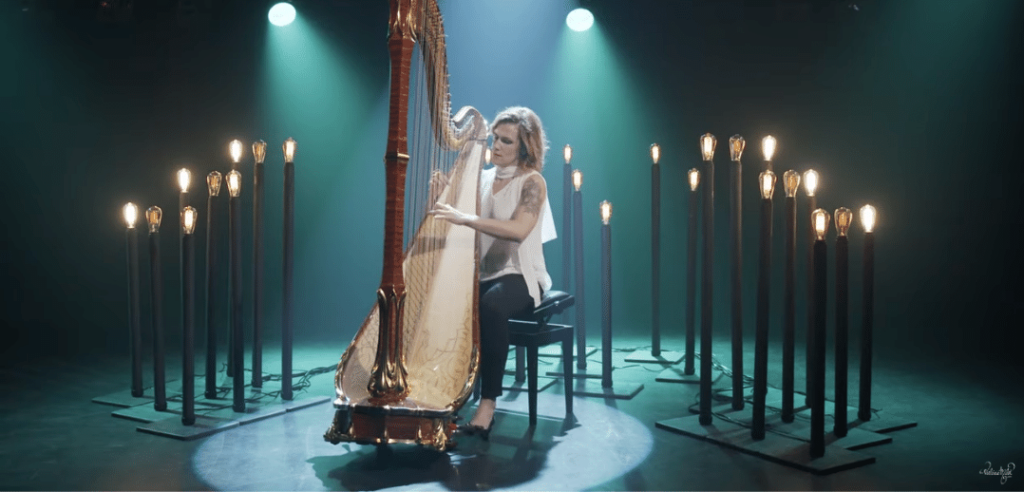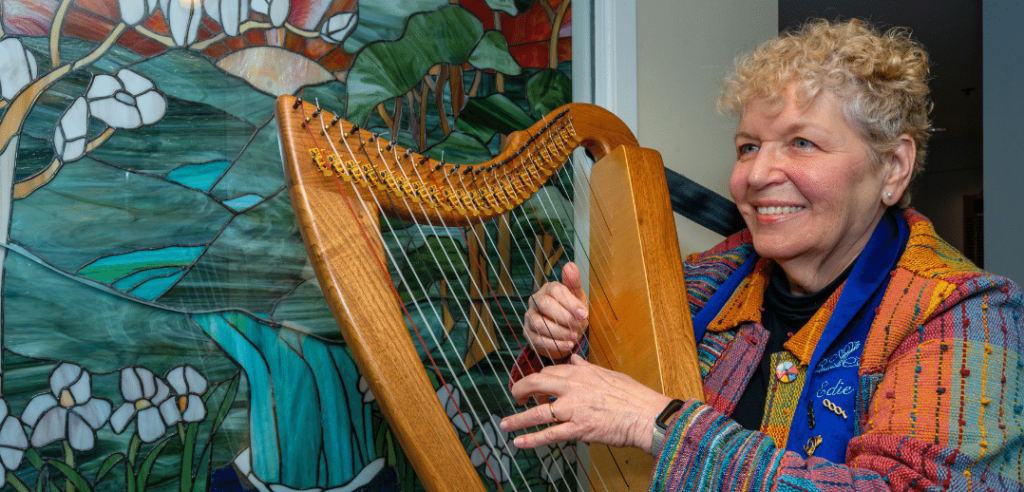Whenever someone asks me what I like best about my work at Harp Column, my answer is always the same—the opportunity to talk to fascinating people who are moving the harp world forward. Angelica Hairston is a perfect example. I met Hairston in 2017. Fresh out of grad school and teaching at the Urban Youth Harp Ensemble in Atlanta, Hairston had agreed to film some music theory instructional videos for Harp Column Academy. In the day I spent with her at the school where she taught, two things about Hairston struck me—she is not satisfied if something is not working, and she doesn’t wait around for someone else to fix it. Case in point—music theory instruction. Her students needed to learn basic music theory, but none of the available teaching materials were geared toward the specific way harpists think about theory. So Hairston created her own theory curriculum, tailoring it to harpists’ specific needs. (Curious what that looks like? Check out Hairston’s theory studio at harpcolumnacademy.com). Unhappy with the lopsided numbers of musicians of color in classical music, Hairston wasted no time. Still in grad school, she created the organization Challenge the Stats to bring awareness to the issue and effect change.
We caught up with Hairston in her home studio last month. On the wall behind her harps were three eight-by-ten black and white photos of three African American harpists who led the way for her career and inspire her work—Pat Terry Ross, retired teacher at the storied Cass Tech harp program in Detroit; Robbin Gordon-Cartier, long-time teacher at the thriving harp program at the Cicily L.Tyson Community School of Performing and Fine Arts in East Orange, N.J.; and Ann Hobson Pilot, the legendary principal harpist of the Boston Symphony, now retired, who became the first Black principal (for any instrument) in an American orchestra when she joined the National Symphony Orchestra in 1966.
…there was something that drew me to this instrument—I was captivated, and it never let me go.
HC: You have so many titles—you’re an educator, activist, speaker, performer, harpist, all these things. Do you think of yourself as one title more than another?
AH: That’s a great question. For me, being an artist is infused in every title that I hold, and the way that I walk down the street, and the way that I put clothes on my body. I’ve always believed that artists are at the center of the conversation around justice in the way that we think creatively and the way that we have learned to collaborate really well with folks that sometimes can’t even speak the same language. When we think about creating a new world for us to live in, it has to be birthed from the creatives and the artists—from those who see the world outside of the bounds of what we see right now.
HC: I understand your father was a music educator. How did that play a role in your musical upbringing?
AH: Growing up I had such a musical family. My father was a band teacher, so all of the brass was in the house—there were saxophones honkin’, there were trumpets blaring. You never knew what he would bring home to prepare for the next day. And my mother, though she wasn’t a musician, was an amazing audience. I also remember going to my grandmother’s church (my mother’s mother) when I was really young, and that music was just incredible. There were no instruments; it was all vocal—it’s stomping on the floor, it’s singing, it’s creating new songs in the moment. And I think that growing up between this traditional band world and the Black church experience shaped me before I even started playing the harp.
HC: How did you find your way to the harp?
AH: I started playing music as a violinist when I was 4 years old with my little squeaky violin. When I was in sixth grade, my parents took me to a symphony concert, and I saw [Atlanta Symphony Orchestra principal harp] Elisabeth Remy Johnson. I heard the sounds of the harp, and I said, “That is what I want to do.” I was drawn to it. I always say the harp chose me, and we just stuck. I started playing, and I haven’t put it down since I was 12 years old.
HC: It seems like this is the case with so many harpists. Playing the harp is not really a choice, it’s just what they feel they must do.
AH: Totally. I think for me, growing up in Atlanta where there’s so much diversity and culture, in that classical music space I didn’t find a lot of musicians who looked like me. I didn’t see a lot of Black women in audiences, I didn’t see a lot of folks of color on stage. I always considered myself a walking juxtaposition in that world. But there was just something that drew me to this instrument—I was captivated, and it never let me go.
HC: I’m always curious how people like yourself who are on a unique career path got there. You started on a traditional route in the harp world, going to the conservatory in Toronto studying with Judy Loman. Now you find yourself leading a forward thinking arts-centered advocacy group that you founded. Tell us about how you have gotten to this point.
I came to understand that so much of teaching is just you being yourself in the middle of a classroom and showing as much love as you can.
AH: My first teacher was Monica Hargrave, who is an African American woman. I started studying with Elisabeth [Remy Johnson] in seventh grade, and I was in a program called the Talent Development Program through the Atlanta Symphony. It was a program for young Black and Latinx musicians who were interested in pursuing classical music seriously. I went through that program, and I went to Tanglewood one summer where I got to work with Ann Hobson Pilot. I had seen her in photos, but to sit across from a musician who looked like me, who would like reach over and demonstrate things on the harp, and to see her hands—the skin tone of her hands was something that was so beautiful and very intimate for me. At that point, I started to understand the value of representation in a whole different light. For me to go to a symphony concert and look up there and see someone who looked like me playing my instrument was absolutely life changing. What struck me about Ann was seeing and working with an African American harpist whose career had reached majors stages and opened doors in the way hers did. Later, I was at the Royal Conservatory, studying with Judy [Loman], having an amazing time practicing my Mozart, working on my trills—I was all in. Around the time of my junior year, there were a lot of social issues starting to bubble up to the surface in the United States. A turning point for me was the murder of Trayvon Martin. I’m up in Toronto, away from the U.S., I’m an African American—maybe only one of two African Americans who were at the Conservatory at that time—and I remember folks would start coming to me talking or asking questions or wanting to engage. I realized at that point that I had such a beautifully developed vocabulary around classical music—I could talk about appoggiaturas all day—but hadn’t necessarily explored what it meant for my music to have a voice in the issues that were happening in my community. I remember being struck by who I was, as a classical musician, and understanding the passion and the charge that I had to use all of this extraordinary knowledge in the classical music world to actually make a difference. So I started to consider these two questions. Who cares? Who actually cares about what’s going on in the world? Who are those people? And how can I be a person who can find the intersection between the art that I love, the instrument that I love, the techniques that I love, and a community and a people that I also love and was birthed from. So that’s where I started to get more creative in thinking about how I could expand beyond what I was expecting to be as an orchestral player, and move into learning more about nonprofits, learning more about the people who are a voice as artists, and using justice as a tool that their artistry elevates. That’s how I ended up in a master’s program in music industry leadership at Northeastern. I did it in 10 months, really quick, because I ended up getting a job at the Urban Youth Harp Ensemble. But that whole pathway led me through this exploration of how my artistry could actually birth even deeper, even further than just playing these notes on the page. What what did it mean? And how can I care about the world?
HC: Tell us about Challenge the Stats and how your work there has evolved over these last seven years.
AH: During those 10 months in Boston when I was doing my master’s, Challenge the Stats came to be. I had an amazing mentor, her name is Margo Saulnier. She would sit with me every single week, and we would just imagine what this intersection could look like. She recommended instead of writing a paper or doing something academic and formal, that I do a concert and see what it would look like if I just explored. That was the first show in Boston in 2017, which was called Challenge the Stats. It was all about some of these statistics around orchestral players of color and the dearth of players that are on stage as well as in the audience and administration. On stage there was Charles Overton, Mason Morton, and I. We all played together, we played some of Maurice Draughn’s works, and used it as a time to explore what this could look like. After that, I ended up moving to Atlanta, because I was teaching with the Urban Youth Harp Ensemble, serving as the artistic director. Atlanta became a launching pad for what is now a thriving organization that serves hundreds of musicians a year. We’re working in schools and providing different kinds of STEAM workshops. We do shows throughout the year. While we started specifically with a Western classical music focus, our mission now celebrates BIPOC [Black, Indigenous, People of Color] artists in the performing arts, not specifically limited to “classical” as it’s traditionally defined. It really has been like a little laboratory for me to continue to be more creative and have an artistic outlet. That again, is even bigger than the harp—recognizing that my career can actually bloom and have arms and branches and expand with [the harp] always being the center of who I am and what I do.
HC: You grew up in Atlanta, then returned after school to work at the Urban Youth Harp Ensemble, and have been there ever since. What is the arts scene like in the city?
AH: Atlanta is a fascinating place. There is a deep Southern influence of the way folks are kind and treat one another. There is a certain pace to the state of Georgia, and yet Atlanta itself is this buzzing, thriving city with incredible diversity of folks who are moving from all over the place. There’s a rich diversity of history and hip-hop, all the way to some really incredible classical artists who call the Southeast and often Atlanta home. I think working as a harpist in this city, or even growing up as a harpist in this city, you often see these cross disciplinary collaborations. You’re often seeing this strong history of justice, that leaches into every area and aspects of what’s done here, like at Ebenezer Baptist Church, which is where my husband and I go. So I think growing up as a harpist, I always saw creative thinkers and people who were willing to think outside of the box, and that helped me in my own journey as well.
HC: Tell us about your experience with the Urban Youth Harp Ensemble and how it shapes the work that you do now.
AH: My experience there was more than I could ever communicate. I remember that moment when I was sitting across from Ann Hobson Pilot as a student, and it brings up a lot of emotion to be that teacher, mentor, friend, supporter, advocate, and cheerleader for young harpists—particularly young African American harpists, who made up about 90 percent of the ensemble when I was there.
I think I learned a lot more about myself through the process of teaching. I learned how important it is for us, as harpists, leaders, and musicians, to continue to pour into the next generation. And I learned how important it is to listen. I learned so much from the brilliance of these young musicians and the way that they thought about music and the way that they thought about the harp. It was such an eye opening experience for me. I used all of the tools that I had learned from my teachers. Elisabeth [Remy Johnson] was tough. She did not play around, but it was great. I needed that, particularly as a Black woman when I went to conservatory. I could play, we could settle on that. If there was an issue, someone was talking about me or someone had an issue, I would just go and practice, and I learned that from Elisabeth.
From Ann Hobson Pilot, I learned to listen, to mentor, to ask questions, and be available for tough questions from young musicians of color. And then of course, from Judy [Loman] I learned about this amazing expanse of sound, teaching technique, teaching curriculum. My time with the Urban Youth Harp Ensemble was amazing, and it also connected me with Robbin Gordon-Cartier and Pat Terry Ross, whose programs I would go and visit to learn how to teach. I came to understand that so much of teaching is just you being yourself in the middle of a classroom and showing as much love as you can.
I stayed [with the Urban Youth Harp Ensemble] until the pandemic and then transferred into more of a consultant role where I’m not in the classroom every day. But my time there really was extraordinary. I love the work that we did there and give a huge thank you to all of the teachers who were there during my time and after.
HC: I read somewhere where you refer to Ann Hobson Pilot as your musical grandmother. Do you still keep in touch with her? What’s your relationship like?
AH: I do, yes. I call her my grandmother, because she has that warm feeling. But also, she was Elisabeth’s teacher, so in terms of lineage, that’s where I see her. She has transitioned to being more of a career coach, giving me ideas on repertoire, and being supportive of me as a holistic person. I really value how much she shares about how she values the work that I do, and that has allowed all of us to take a step further and have more conversations about race, equity, and the way that music can really be a force for change.
HC: I want to ask you a little bit more about Challenge the Stats. When you started this organization in 2017, only about four percent of members of American orchestras were Black or Latinx, and there were similar disparities in the orchestra management and classical audiences. It’s been six years, which isn’t a long time, but have you seen any changes in those numbers since then?
AH: That’s a complex question. Those statistics come from the League of American Orchestras. They released another study about two years ago, and the numbers really hadn’t shifted in the past 16 years. But when we think about equity and our field, what I have seen is an expansiveness around what the word “classical” means. Traditionally, “classical” puts a particular box around what the repertoire might be, who is supported in that space, or even the ideal career for a musician in the 21st century. The biggest change I’ve seen is that these statistics are now becoming narrow because there is such an expansiveness around what it means to create a performing career. Particularly among many musicians of color, I’ve seen a lot of creative and unique ways that music is expanding beyond playing in an orchestra. Sure, that might be one thing that a musician does, but there are all these new pathways now. After the pandemic, we’re seeing the world connect globally, we’re seeing how the global majority—folks of color—are making those connections, the way that more music is being written that might not be considered “classical,” yet still has that instrumental touch. It’s getting us to think more creatively about how we gather some of these numbers and measures [within classical music]. So I’ve certainly seen growth in the networks of musicians of color, growth in the way that folks are supporting the next generation, growth in the number of musicians getting to the conservatory level and having support post-conservatory, and growth in what a successful career in music might look like.
HC: We all know that the harp can be an isolating instrument—we sit at the back of an orchestra by ourselves, we don’t play a lot of chamber music, we don’t have a section to play with. You’ve talked about the isolation of being a person of color in the classical space as well. How have you learned to deal with the feeling of isolation in classical music?
AH: That’s a great question. I think when you are a person of color, particularly as a harpist, you are often the first or the only to do a myriad of different things. When I was younger, it was always celebrated—the first to win this competition or the first to go to this conservatory—anywhere I went, I was the first Black harpist to have done it. It is celebrated, but there’s also a burden in that. I think for me what helped was forming a community where I could call someone like Ann Hobson Pilot and say, “Hey, here’s what’s going on. I don’t feel celebrated for being the first, I feel exhausted, I feel alone, I feel angry.” I continue to remind myself of the people who opened the doors for me, and the fact that my job is to open as many doors as possible, so that all of those musicians coming after me don’t have to always be the only one walking through the door. I can be on the other side to be that mentor and supporter for folks. I was grateful to have the [Atlanta Symphony] Talent Development Program, which gave me a community of support. But it is, I think, an additional burden and additional intersection that folks of color have to navigate as the only person of color in a lot of these spaces.
HC: A few months ago, we featured a harpmaker, Joris Beets, who was trying to “democratize” the harp by making quality instruments at a price point that’s affordable to many. Through the work that you’ve done teaching and in your community, what do you see as the most important things that could be done to make the harp accessible to more young people in communities where the instrument has always had a lot of barriers to entry?
AH: I think one of the one of the biggest things is visibility—for young musicians to see musicians who are succeeding in this career in various ways. Diversity of role models for young musicians is huge. I think accessibility financially, of course, is a big barrier, whether that’s being able to access a good quality instrument from a young age, a vehicle to transport the instrument, or a family member to take the child to the lesson in another part of town. I think repertoire is also important. Sometimes when we start students young, it could be a while before you touch a piece by a musician of color, if you do at all, so having early repertoire is important. I know Maurice Draughn has some, and Brandee Younger has released some. Starting repertoire and introducing young musicians to a myriad of different composers, artists, genres, and styles is another way that we can make the harp less of a boxed instrument, and put it into these juxtaposed places that we wouldn’t always expect.
HC: You’re not very old, but you’ve already done a lot of new things in your career. What is next for you?
AH: There are two things that come to mind. I was honored last year to get a Sphinx Empower Award to go to Ghana. I spent that time researching some of the history of the harp and some of the earlier ancestors of the harp. I think learning and exploring around the world in more of a continental way is definitely something that I would love to continue to do, particularly in Africa. Exploring more of how much this instrument that we play has roots in my country of origin is big for me.
Second, I’ve been doing a lot of work in the sphere of rest as a form of social justice. There is a brilliant thinker, Tricia Hersey, and she has an organization called the Nap Ministry. I’ve been doing a lot of playing with this ministry whose idea is that our world is moving so quickly and so fast that to actually pause and sit and breathe and listen to music is actually an act of resistance against this constant churning. So I have a show in December with a wonderful vocalist where the two of us will explore the world of rest as a tool for justice and reparations. I’m really looking forward to that. •
All About Angelica

What is your favorite footwear at the harp?
Probably socks or flats.
What is your favorite takeout food to order?
I am a big fan of Bangladeshi food. Bangladeshi or Ethiopian. Those are the two go-tos for me.
What is your favorite show that you’ve watched in the last year
I’ve been watching the show called “Ugly Delicious” on Netflix. I just love food shows and cooking shows. It’s really good.
What are the first three things that you do in the morning?
Probably the first thing is go back to sleep. [Laughs] I’m not a morning person. I like to do some breathing exercises, a little breath work to kind of get my day going. I generally take a walk. And I like to journal. Those are my morning practices.
What are the best and worst things about playing the harp?
I think the best thing is you are always a captivating unicorn to most people who hear you. And the worst thing is probably just keeping the harp in tune.
What’s your biggest phobia?
I know this is really weird. There’s an old superstition about people sweeping your feet. I know it’s weird. It’s bad luck. So whenever someone’s sweeping the floor, I have a lot of anxiety because I just don’t want my feet to get swept.
What would you say is the luckiest moment in your life?
Probably playing at Palm Heights Resort in Grand Cayman. That was amazing.
If you weren’t a harpist, what would you do for a living?
I have a fascination with psychology, so I might be some type of researcher in the area of psychology.





